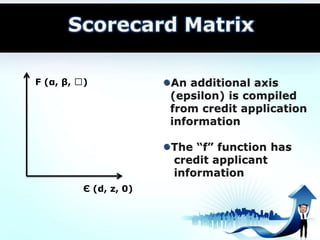Larry Chiang Federal Reserve Bank Credit Scorecard Matrix Credit To Debit Reporting
- 1. Larry Chiang
- 2. Bad NewsThe Supermodel is male and his name is . . .
- 3. Larry Chiang
- 4. B I O
- 5. Thin File AnalysisOpen-sourced decision-making model developed by the Supermodel,Larry ChiangITŌĆÖS FREE
- 6. Scorecard MatrixAn additional axis (epsilon) is compiled from credit application information
- 7. The ŌĆ£fŌĆØ function has credit applicant informationF (╬▒, ╬▓, Ō▒▒)ąä (d, z, 0)
- 8. Define RiskBy adjusting the slope ŌĆ£PŌĆØ, you define your risk appetiteŲÆSlope PWhen p=0 ąä not a factorWhen p is , ąä is ONLY factor ąä
- 9. Case Study to Determine RiskBy adjusting the slope ŌĆ£PŌĆØ, you define your risk appetiteŲÆLess risk (higher up ŌĆ£ŲÆŌĆØ axis)More riskąä
- 10. Case Study ŌĆō Which to WeighMore-- ŲÆ? Or ŌĆ£epsilonŌĆØ? ŲÆFocus mainly on ŌĆ£ŲÆŌĆØFocus is on ŌĆ£ąäŌĆØąä not a factor ŌĆō simple old systemPure ąä function(3)(2)(1)ąä(4)
- 11. Once Risk Is SelectedMultiple ScorecardScenarioSingleScorecardScenarioŲÆŲÆABBCąäąä
- 12. Scorecard Matrix/Credit Line MatrixEstablish multiple points forwide range of credit linesAdd another dimension!3-D ScorecardMatrixŲÆŲÆŲÆlląäŲÆllbreaks out scorecard factors from ŲÆ ąä
- 13. Risk SelectionGoes from a simple slope to an entire planeSelect pointswithin plane!ŲÆRisk PlaneŲÆlląä
- 14. China Debit Reporting AnalysisDebit Decision-Making Model developed by the Supermodel,Larry Chiang
- 15. Supply Vs. DemandI argue that supply is related to demandOren Michels, CEO MasheryLarry Chiang, CEO Duck9Pete Cashmore, Founder Mashable
- 16. RatesThe higher the supply of banks in competition for consumers, the more competitive the interest rate, junk fees, etc.
- 17. Larry ChiangElectronic Credit Score Protection Bill/ActCredit disputes via email, web & fax should have the same weight as a letter mailed via the Post Office.
















